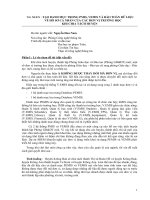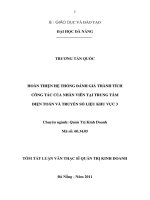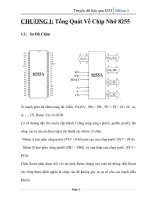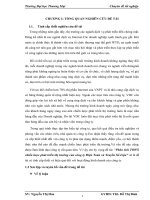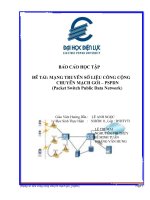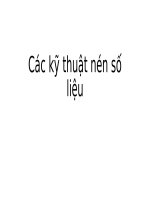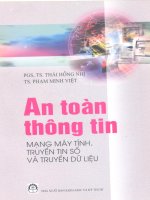TRUYỀN SỐ LIỆU VÀ MẠNG Ch02 data communications
Bạn đang xem bản rút gọn của tài liệu. Xem và tải ngay bản đầy đủ của tài liệu tại đây (3.53 MB, 76 trang )
Data Communication and
Networking
Dr. –Ing. Vo Que Son
Email:
Telecomm. Dept.
Faculty of EEE
DCN
HCMUT
1
Content
Chapter 1: Medium of PHY Layer
Wired and Wireless Media
Physical layer standards: RS232, RS422, RS485
Line Coding
Digital modulation/demodulation
Channel parameters
Gaussian noise and BER
Chapter 2: Data Communications
Asynchronous transmission
Synchronous transmission
Channel Coding
Data Compression
Telecomm. Dept.
Faculty of EEE
DCN
HCMUT
2
Coding schemes
EBCDIC (Extended Binary Coded Decimal Interchange
Code):
Invented by IBM
8-bit character encoding used mainly on IBM mainframe and
IBM midrange computer operating systems.
ASCII (American Standards Committee for Information
Interchange): defined by ITU-T
character-encoding scheme originally based on the English
alphabet that encodes 128 specified characters - the numbers 09, the letters a-z and A-Z, some basic punctuation symbols,
some control codes that originated with Teletype machines, and
a blank space - into the 7-bit binary integers.
ASCII codes represent text in computers, communications
equipment, and other devices that use text. Most modern
character-encoding schemes are based on ASCII, though they
support many additional characters.
Telecomm. Dept.
Faculty of EEE
DCN
HCMUT
3
EBCDIC Table
Data characters
Control characters
Telecomm. Dept.
Faculty of EEE
DCN
HCMUT
4
ASCII Table
Data characters
Control characters
Telecomm. Dept.
Faculty of EEE
DCN
HCMUT
5
ASCII Table
ASCII unprintable
characters:
Telecomm. Dept.
Faculty of EEE
DCN
HCMUT
6
Network Topology
Bus
Point-to point
Star
Multipoint
Ring
Mesh
Telecomm. Dept.
Faculty of EEE
DCN
HCMUT
7
Communication types
Simplex communication is
permanent uni-directional
communication (e.g. Radio, TV)
Half duplex: A half duplex link
can communicate in only one
direction, at a time. Two way
communication is possible, but
not simultaneously. E.g. talkback radio, Citizen Bands radio
Full duplex communication is
two-way communication
achieved over a physical link that
has the ability to communicate in
both directions simultaneously.
E.g. Telephone system
Telecomm. Dept.
Faculty of EEE
DCN
HCMUT
8
Transmission modes
The transmission of binary data across a link can be
accomplished in either parallel or serial mode. In parallel
mode, multiple bits are sent with each clock tick. In serial
mode, 1 bit is sent with each clock tick. While there is only one
way to send parallel data, there are three subclasses of serial
transmission: asynchronous, synchronous, and isochronous.
Telecomm. Dept.
Faculty of EEE
DCN
HCMUT
9
Parallel transmission
Bits are transmitted in bus at the same time
High speed over short distance
Example: PC-printer
Telecomm. Dept.
Faculty of EEE
DCN
HCMUT
10
Serial transmission
Bits are transmitted over one line sequentially
Low speed over long distance
Asynchronous and Synchronous transmission
Telecomm. Dept.
Faculty of EEE
DCN
HCMUT
11
Timing
Timing problems require a mechanism to synchronize the
transmitter and receiver
Timing of bits is the key!
How can we control the timing?
System A
System B
…11010010
Telecomm. Dept.
Faculty of EEE
DCN
HCMUT
12
Asynchronous transmission
Asynchronous here means “asynchronous at the byte level,”
but the bits are still synchronized; their durations are the
same.
Each character of data is treated independently
Telecomm. Dept.
Faculty of EEE
DCN
HCMUT
13
Synchronous transmission
In synchronous transmission, we send bits one after another
without start or stop bits or gaps. It is the responsibility of the
receiver to group the bits.
For sending large blocks of data
Control schemes
Character-oriented
Bit-oriented
Telecomm. Dept.
Faculty of EEE
DCN
HCMUT
14
Asynchronous Transmission
Asynchronous
Data transmitted one character at a time
5 to 8 bits
Timing only needs to be maintained within each character
Transmitter and Receiver clocks need not be in sync
Resynchronize at the beginning of each character
Behavior:
In a steady stream, interval between characters is uniform
• Length of stop element
In idle state
• Receiver looks for transition 1 to 0
Then samples next seven intervals
• Char length
Then looks for next 1 to 0 for next char
Telecomm. Dept.
Faculty of EEE
DCN
HCMUT
15
Asynchronous Transmission
Diagram
Advantages:
Simple
Cheap
Overhead of 2 or 3
bits per character
(~20%)
Good for data with
large gaps (e.g.
keyboard)
Telecomm. Dept.
Faculty of EEE
DCN
HCMUT
16
Asynchronous Transmission
How can the receiver detect bits?
How can the receiver receive the whole byte?
How can the receiver receive the whole frame?
Common synchronization techniques
Bit synchronization
Byte synchronization
Frame synchronization
Telecomm. Dept.
Faculty of EEE
DCN
HCMUT
17
Asynchronous Transmission
Bit Synchronization
Clock rate at the
receiver is N times
clock rate at
transmitter
When detecting the
start bit transition,
using N/2 and N
counters to sample
bits until the end of
the character
Telecomm. Dept.
Faculty of EEE
DCN
HCMUT
18
Asynchronous Transmission
If N is larger, the
sampling is more
precise
Usually, N=16
Telecomm. Dept.
Faculty of EEE
DCN
HCMUT
19
Asynchronous Transmission
Byte synchronization: the configuration of transmission must
be the same at the transmitter and receiver
Start bit: 1
Data bits: 4,5,6,7,8
Parity bit: 0, 1 (even or odd)
Stop bit: 1, 1.5, 2
Telecomm. Dept.
Faculty of EEE
DCN
HCMUT
20
Asynchronous Transmission
Frame synchronization:
If Blocks of printable characters
Encapsulate complete block between two special (nonprintable) transmission control characters
• STX : Start-of-text
• ETX : End-of-text
Telecomm. Dept.
Faculty of EEE
DCN
HCMUT
21
Asynchronous Transmission
If Binary data
e.g., Contents of a file
containing a compiled
program
Use of single ETX not
sufficient to indicate the
end of a file
• One of the bytes might be the
same as an ETX character
Solution: STX and ETX are
preceded by another
transmission control
character
• Data link escape (DLE)
Character or byte stuffing
Telecomm. Dept.
Faculty of EEE
DCN
HCMUT
22
Example
DTE A transmits to DTE B a sequence of characters:
T S L DLE
The message is transmitted in Asynchronous mode using
RS232 (8-bit data, 1 parity bit, 1 stop bit), R=1200 bps and
characters are in ASCII code
Show the data frame? (If transmitting: T S L DLE ETX? What is
the transmitted frame?)
Determine the time to transmit this data frame (ignoring the
processing time) and the effficiency?
DLE STX
T
S
L
DLE DLE DLE ETX
T = (9 x 11)/1200 = 82.5 ms
Telecomm. Dept.
Faculty of EEE
DCN
HCMUT
23
Synchronous Transmission
Disadvantages of Asynchronous transmission
Bit synchronization is too difficult when increasing bit
rate
High overhead
Synchronous transmission
Data has been transmitted in blocks
Two approaches
• Character-oriented
• Bit-oriented
Both use the same bit synchronization methods
Major difference is in how they achieve character &
frame synchronization
Telecomm. Dept.
Faculty of EEE
DCN
HCMUT
24
Synchronous Transmission
Bit level: Block of data transmitted without start or
stop bits
Tx and Rx clocks must be synchronized!!!
Option 1 -- Can use separate clock line
Good over short distances
Subject to impairments
Option 2 -- Embed clock signal in data
Manchester encoding
Carrier frequency (analog)
Telecomm. Dept.
Faculty of EEE
DCN
HCMUT
25
